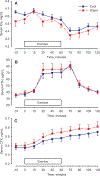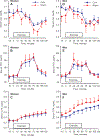Dermal Calcium Loss Is Not the Primary Determinant of Parathyroid Hormone Secretion during Exercise
- PMID: 31009423
- PMCID: PMC6746591
- DOI: 10.1249/MSS.0000000000002017
Dermal Calcium Loss Is Not the Primary Determinant of Parathyroid Hormone Secretion during Exercise
Abstract
Introduction: Exercise can cause a decrease in serum ionized calcium (iCa) concentration, which stimulates parathyroid hormone (PTH) secretion and activates bone resorption. We postulated that dermal Ca loss during cycling exercise is the major determinant of the serum iCa, PTH, and bone resorption (C-terminal telopeptide of type 1 collagen [CTX]) responses.
Methods: To investigate this, women (n = 13) and men (n = 12) age 18 to 45 yr performed the same exercise bout under cool (18°C) and warm (26°C) conditions. Exercise was 60 min of cycling at ~75% of peak aerobic power. Sweat samples were obtained during exercise using a skin patch method, and blood samples were obtained before and during exercise and during 60 min of recovery.
Results: Sweat volume and estimated sweat Ca loss were 50% higher for the warm condition than the cool condition. Despite this, there were no differences between thermal conditions in the changes (mean, 95% confidence interval [95% CI]) in iCa (cool, -0.07 mg·dL; 95% CI, -0.16 to 0.03); warm, -0.07 mg·dL; 95% CI, -0.20 to 0.05), PTH (cool, 34.4 pg·mL; 95% CI, 23.6-45.2; warm: 35.8 pg·mL; 95% CI, 22.4-49.1), or CTX (cool, 0.11 ng·mL; 95% CI, 0.08-0.13; warm, 0.15 ng·mL; 95% CI, 0.11-0.18). Adjusting for exercise-related shifts in plasma volume revealed a marked decline in vascular iCa content in the first 15 min of exercise (cool, -0.85 mg·dL; 95% CI, -1.01 to -0.68; warm, -0.85 mg·dL; 95% CI, -1.05 to -0.66), before substantial sweat Ca loss had occurred.
Conclusions: This indicates that dermal Ca loss was not the primary trigger for the increases in PTH and CTX during exercise. Further research is necessary to understand the causes and consequences of the disruption in Ca homeostasis during exercise and specifically the extravascular shift in iCa.
Conflict of interest statement
Conflict of Interest
We have no conflicts of interest to declare. The results of the study are presented clearly, honestly, and without fabrication, falsification, or inappropriate data manipulation. Results of the present study do not constitute endorsement by ACSM.
Figures



Similar articles
-
Bone Biomarker Response to Walking under Different Thermal Conditions in Older Adults.Med Sci Sports Exerc. 2019 Aug;51(8):1599-1605. doi: 10.1249/MSS.0000000000001967. Med Sci Sports Exerc. 2019. PMID: 31083027 Free PMC article.
-
Maintenance of Serum Ionized Calcium During Exercise Attenuates Parathyroid Hormone and Bone Resorption Responses.J Bone Miner Res. 2018 Jul;33(7):1326-1334. doi: 10.1002/jbmr.3428. Epub 2018 Apr 18. J Bone Miner Res. 2018. PMID: 29572961 Free PMC article. Clinical Trial.
-
Calcium Supplementation Attenuates Disruptions in Calcium Homeostasis during Exercise.Med Sci Sports Exerc. 2017 Jul;49(7):1437-1442. doi: 10.1249/MSS.0000000000001239. Med Sci Sports Exerc. 2017. PMID: 28248693 Free PMC article. Clinical Trial.
-
Effects of the circadian variation in serum cortisol on markers of bone turnover and calcium homeostasis in normal postmenopausal women.J Clin Endocrinol Metab. 1998 Mar;83(3):751-6. doi: 10.1210/jcem.83.3.4627. J Clin Endocrinol Metab. 1998. PMID: 9506720 Review.
-
1alpha(OH)D3 One-alpha-hydroxy-cholecalciferol--an active vitamin D analog. Clinical studies on prophylaxis and treatment of secondary hyperparathyroidism in uremic patients on chronic dialysis.Dan Med Bull. 2008 Nov;55(4):186-210. Dan Med Bull. 2008. PMID: 19232159 Review.
Cited by
-
Environmental Factors That Affect Parathyroid Hormone and Calcitonin Levels.Int J Mol Sci. 2021 Dec 21;23(1):44. doi: 10.3390/ijms23010044. Int J Mol Sci. 2021. PMID: 35008468 Free PMC article. Review.
-
The effect of calcium supplementation on calcium and bone metabolism during load carriage in women: protocol for a randomised controlled crossover trial.BMC Musculoskelet Disord. 2023 Jun 16;24(1):496. doi: 10.1186/s12891-023-06600-w. BMC Musculoskelet Disord. 2023. PMID: 37328859 Free PMC article.
-
One Season in Professional Cycling Is Enough to Negatively Affect Bone Health.Nutrients. 2023 Aug 18;15(16):3632. doi: 10.3390/nu15163632. Nutrients. 2023. PMID: 37630821 Free PMC article.
-
Maintaining serum ionized calcium during brisk walking attenuates the increase in bone resorption in older adults.Bone. 2021 Dec;153:116108. doi: 10.1016/j.bone.2021.116108. Epub 2021 Jul 9. Bone. 2021. PMID: 34252605 Free PMC article.
-
The Ability of Exercise to Mitigate Caloric Restriction-Induced Bone Loss in Older Adults: A Structured Review of RCTs and Narrative Review of Exercise-Induced Changes in Bone Biomarkers.Nutrients. 2021 Apr 10;13(4):1250. doi: 10.3390/nu13041250. Nutrients. 2021. PMID: 33920153 Free PMC article.
References
-
- Scott JP, Sale C, Greeves JP, Casey A, Dutton J, Fraser WD. The role of exercise intensity in the bone metabolic response to an acute bout of weight-bearing exercise. J Appl Physiol. 2011;110(2):423–32. - PubMed
-
- Haakonssen EC, Ross ML, Knight EJ, Cato LE, Nana A, Wluka AE, et al. The effects of a calcium-rich pre-exercise meal on biomarkers of calcium homeostasis in competitive female cyclists: a randomised crossover trial. PLoS One. 2015;10(5):e0123302 Epub 2015/05/15. doi: 10.1371/journal.pone.0123302. - DOI - PMC - PubMed

